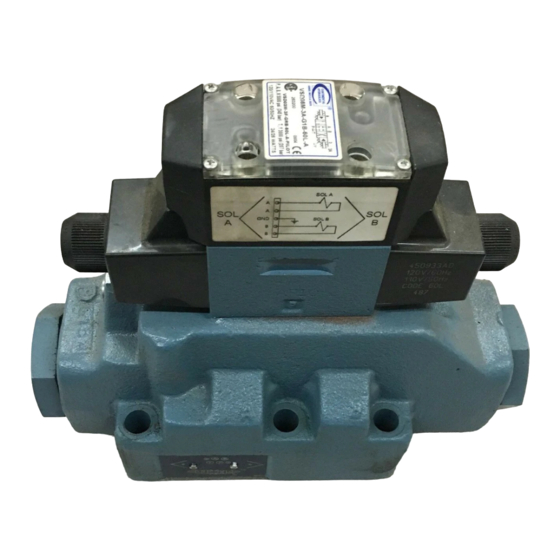Advertisement
Quick Links
CAUTION – Before performing any service
operation on any Directional Control Valve,
be sure that all pressure has been relieved
from BOTH SIDES of the system.
CAUTION – Before performing any service
operation on any Directional Control Valve,
disconnect or lock off power supply.
CAUTION – Before manually actuating any
Directional Control Valve, be sure that any
resulting machine function will not endanger
persons or equipment.
PRODUCT IDENTIFICATION
Each Directional Control Valve has an Ordering
Code printed on its cover label. See Figure 1 for the
location of the Ordering Code.
This Service Booklet applies to products with
Ordering Codes like the sample in Figure 2.
Ordering
Code
GENERAL SPECIFICATIONS
RECOMMENDED FLUID
Petroleum, water-based fluids (not more than 40%
water) and most phosphate esters. Other fluids may
be acceptable, but special O-rings may be required.
Viton seals are standard.
FLUID TEMPERATURE RANGE
Fluid temperature up to 200° F. (93° C.) will not
appreciably affect valve performance. However, for
safety reasons, temperatures above 130° F. (54° C.)
are not recommended.
SERVICE MANUAL
VSD08M Solenoid Actuated, Pilot Operated
Basic Valve
Function
Spool Type
Seal Type
Mechanical Options
Pilot and Drain Location
Electrical Options
Solenoid Type
Solenoid Manufacturer
Design Letter
RECOMMENDED OPERATING VISCOSITY
80 to 350 SUS (16 to 75 CS).
FILTRATION
ISO 18/16/13 or better.
MOUNTING POSITION
Any unrestricted position acceptable. Horizontal
mounting preferred.
NFPA FLOW PATH/ACTUATING PATTERN
SOLENOID, AIR AND OIL ACTUATED:
Actuating operator a – connects flow to cylinder
port A.
Actuating operator b – connects flow to cylinder
port B.
GENERAL INFORMATION
SOLENOID ACTUATED – Spring centered and
spring offset valve types will be spring positioned
unless actuated continuously. Detented, no-spring
valves may be actuated momentarily. When
solenoid is not actuated, the spool will remain in last
position attained, provided there is no severe shock,
vibration or pressure surge.
Pressure surges in a common tank line serving
these and other valves can be great enough to
cause inadvertent valve shifting. This is particularly
critical in the no-spring, detented type valves.
Separate tank lines may be necessary.
NOTE: Any sliding spool valve held shifted under
pressure for long periods may stick and not spring
return due to fluid residue formation. To prevent
Figure 1
sticking, valves should be cycled periodically.
PREVENTIVE MAINTENANCE
After Directional Control Valves have been put in
operation, provide periodic inspection and
maintenance. The check points listed below will
assist you in extending the life of your Continental
valves.
Fluid Operating Temperature – Fluid temperature
at the reservoir during operation should be kept
between 100° F. and 130° F. (37° C. and 54° C.).
Form No. 264587 8/03
Directional Control Valves
"A" Design Series
VSD08M - _ _ - G _ _ _ - _ _ _ - _
Figure 2
1
Advertisement

Subscribe to Our Youtube Channel
Summary of Contents for Continental Hydraulics VSD08M
- Page 1 SERVICE MANUAL VSD08M Solenoid Actuated, Pilot Operated Directional Control Valves “A” Design Series Basic Valve VSD08M - _ _ - G _ _ _ - _ _ _ - _ Function Spool Type Seal Type Mechanical Options Pilot and Drain Location...
- Page 2 PART AND ASSEMBLY IDENTIFICATION The parts drawing and parts list on Page 3 may be VSD08M VALVE REPAIR PROCEDURES used to identify individual parts and assemblies in DISASSEMBLY and REASSEMBLY directional control valves. GENERAL...
- Page 3 PART # DESCRIPTION 3, 5 167816 Spring Retainer REQ’D 3, 5 253262 Spring Retainer w/A*C,F*C Spools VSD08M-1A-GR- XX - XX VSD08M-2A-GR- XX - XX 1 Only 167817 Spring Retainer VSD08M-3F-GR- XX - XX 3, 5 254762 Washer VSD08M-5F-GR- XX - XX...
- Page 4 12520 Quentin Avenue South Savage, MN 55378 U.S.A. Phone: (952) 895-6400 Fax: (952) 895-6444 Because Continental Hydraulics is continually improving its products, specifications and appearance are subject to change without notice. Form No. 264587 8/03 © 2003 Continental Hydraulics Printed in U.S.A.




Need help?
Do you have a question about the VSD08M and is the answer not in the manual?
Questions and answers